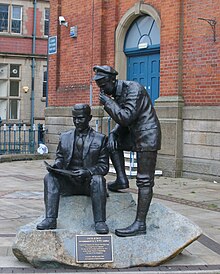Stalybridge
| Stalybridge | ||
|---|---|---|
|
|
||
| Coordinates | 53 ° 29 ′ N , 2 ° 2 ′ W | |
| Basic data | ||
| Country | United Kingdom | |
|
Part of the country |
England | |
| Metropolitan Borough | Tameside | |
| ISO 3166-2 | GB-TAM | |
| region | North West England | |
| Residents | 22,568 (2008) | |
|
View over Stalybridge
|
||
Stalybridge ( steɪlɪˈbrɪdʒ ) is a town in the north of England , about 10 km from Manchester . The city is located in the Metropolitan Borough of Tameside on the banks of the River Tame of Greater Manchester County in the North West England region and has a population of 22,568 (October 2008).
The name was originally Stavelegh, from the Old English staef leah ("forest from which the sticks / sticks are cut"). The medieval feudal lords of the castle ( Lords of the manor ) bore the name de Stavelegh , later changed to Stayley or Staley .
General
A flint scraper from the late Stone Age / early Bronze Age is the oldest evidence of human settlement. Two Bronze Age stone piles, the remainder of a Roman road between Mamucium (Manchester) and Melandra Castle in Derbyshire and the medieval Buckton Castle are other historical testimonies.
At the time of the industrial revolution , Stalybridge became a center of cotton manufacturing. The first water-powered spinning mills were built on the River Tame, replaced by steam mills in 1793. The introduction of cotton spinning machines brought a large increase in textile companies. In 1834 there were already two bridges over the River Tame. The social and political unrest of the Chartists also met with broad approval in Stalybridge. Friedrich Engels named the situation in this textile workers' city as an example in his 1845 work “ The Situation of the Working Class in England ” . In 1844 the city was connected to the railway network, at which time the first large forge was founded. After the decline of the textile industry in the 20th century, the city became a more rural community again.
The Huddersfield Narrow Canal , built from 1794 onwards, a former water transport route, has been repaired in recent years as a tourist magnet and expanded for river trips by houseboat.

Culture
Probably the first civil brass band in the world, "The Stalybridge Old Band" , was founded here in 1809.
In 1912 Jack Judge composed the song " It's a Long Way to Tipperary " in a tavern in town . A bronze statue placed in front of the town hall commemorates the composer.
The Astley Cheetham Art Gallery is a visual arts exhibition center. Benjamin Disraeli described the city in his work "Coningsby" .
Web links
- Stalybridge (Tameside Metropolitan Borough Council website)
- Astley Cheetham Art Gallery (Tameside Metropolitan Borough Council website)
Individual evidence
- ^ Friedrich Engels: The Condition of the Working Class in England in 1844. BiblioBazaar, 2007, ISBN 978-1-4346-0825-3 .
- ↑ View of the bronze statue in front of the town hall. Google Maps , accessed December 16, 2015 .

